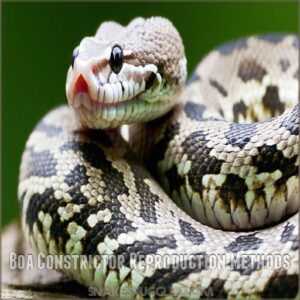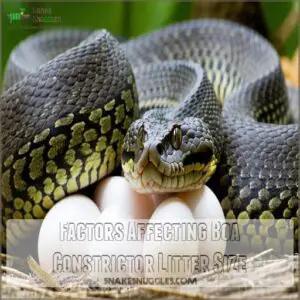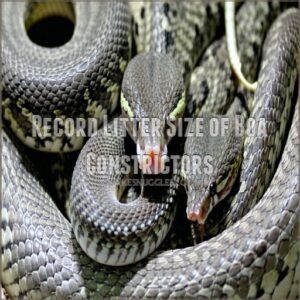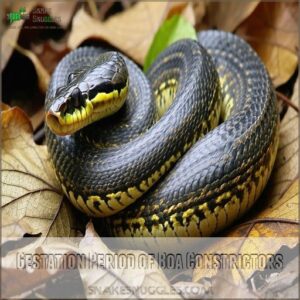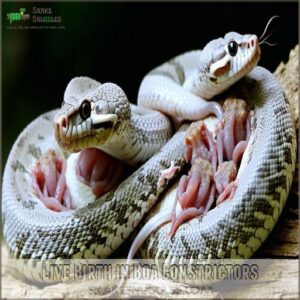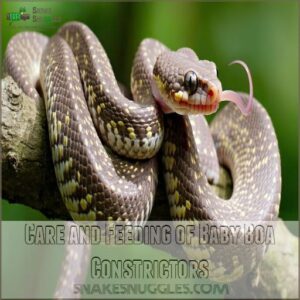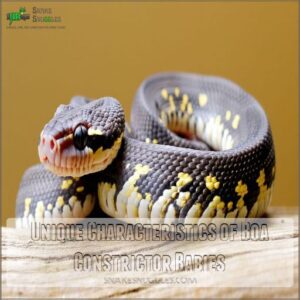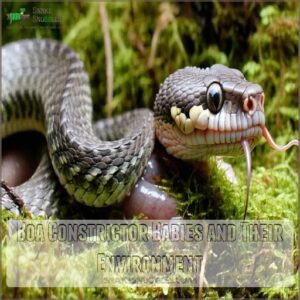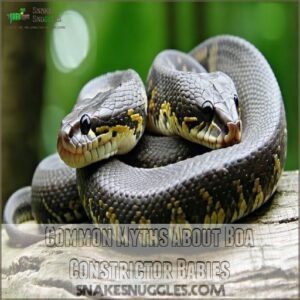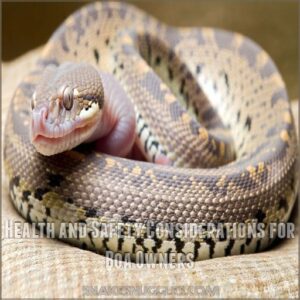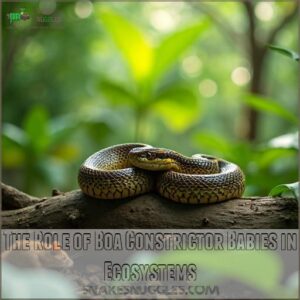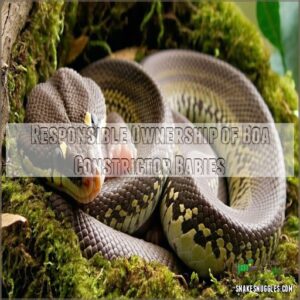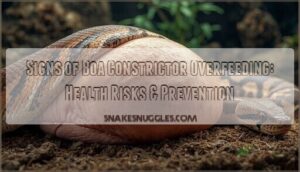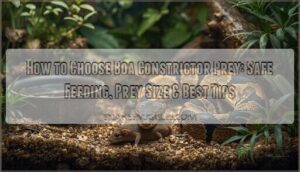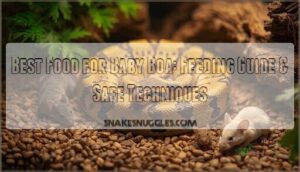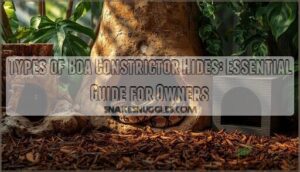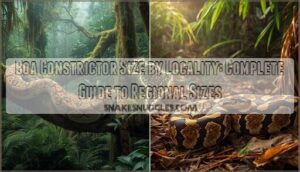This site is supported by our readers. We may earn a commission, at no cost to you, if you purchase through links.
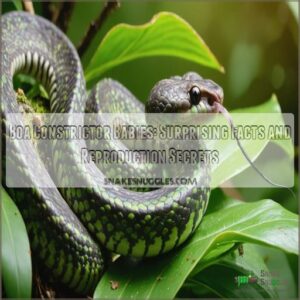
Born through live birth, they can number from a few to over fifty in a single litter.
Notably, boas can reproduce without a partner through parthenogenesis, a sort of "self-starter kit."
With their vibrant colors and immediate hunting skills, these babies are ready to slither into action.
Understanding their diet, heating, and habitat needs is important for new keepers.
As these young boas grow, they play a vital role in controlling pest populations.
Curious about their unique adaptations?
Table Of Contents
- Key Takeaways
- Boa Constrictor Reproduction Methods
- How Many Babies Do Boa Constrictors Have
- Birth and Development of Boa Constrictor Babies
- Care and Feeding of Baby Boa Constrictors
- Unique Characteristics of Boa Constrictor Babies
- Boa Constrictor Babies and Their Environment
- Common Myths About Boa Constrictor Babies
- Health and Safety Considerations for Boa Owners
- The Role of Boa Constrictor Babies in Ecosystems
- Responsible Ownership of Boa Constrictor Babies
- Frequently Asked Questions (FAQs)
- How many babies does a boa constrictor have?
- Has a boa constrictor had 14 babies?
- How does a boa constrictor give birth?
- How do you take care of a baby boa constrictor?
- Can boa constrictors reproduce asexually?
- How long do boa constrictor babies live?
- What are boa constrictor babys defenses?
- Do boa constrictor babies need special care?
- How big are newborn boa constrictors?
- Conclusion
Key Takeaways
- You’ll find that boa constrictor babies can be born through a remarkable process known as parthenogenesis, allowing females to reproduce without a mate.
- These baby boas are vibrant and instinctive hunters right from birth, playing a crucial role in controlling pest populations in their ecosystems.
- To ensure a happy and healthy baby boa, provide a warm, humid environment and regular, appropriately sized meals.
- Despite myths, these snakes are neither venomous nor inherently aggressive, but they require gentle handling to prevent stress.
Boa Constrictor Reproduction Methods
You’ll discover that boa constrictors reproduce in fascinating ways, sometimes even without a male!
We’ll explore both sexual reproduction, where a male and female are involved, and the surprising phenomenon of parthenogenesis, a type of asexual reproduction where females can produce offspring on their own – talk about independence!
Parthenogenesis in Snakes
Ever wondered how a snake can become a mom without a dad in sight?
Enter parthenogenesis: a quirky form of asexual reproduction where boa constrictor babies, just like Ronaldo the boa, arrive without a male’s help.
It’s like nature’s secret trick for snake reproduction, driven by environmental factors and offering insights into genetic diversity and evolution.
Fascinating, right?
Often requiring specialized breeding products and equipment for successful rearing, such as those found in boa constrictor breeding supplies.
Asexual Reproduction in Boas
Sometimes boas have a trick up their scales with asexual reproduction, known as parthenogenesis.
This marvel doesn’t require a mate, sparking questions about evolutionary advantages and environmental triggers.
Limited genetic diversity could be a snag, but it’s a fascinating twist in boa constrictor breeding.
Scientists are keen to explore these mechanisms, opening doors for future research into these ‘solo’ boa constrictor babies.
Virgin Birth in Boa Constrictors
Imagine a boa constrictor, surprising everyone with a virgin birth!
This unusual phenomenon, known as parthenogenesis, lets boa constrictors reproduce asexually, bypassing the need for a male.
These rare reptile reproduction events hold fascinating genetic implications, challenging our understanding of snake evolution.
It’s like nature’s magic trick, where future research might shed light on more about these mind-boggling boa constrictor babies.
How Many Babies Do Boa Constrictors Have
You might be surprised to learn that boa constrictors can give birth to as many as 60 little boas at once, though the average litter usually ranges from 10 to 30.
This impressive range can be influenced by factors like the mother’s age and size, making each birthing event a unique reptilian spectacle.
Average Litter Size of Boa Constrictors
Did you know female boa constrictors typically give birth to 10 to 65 hatchlings at a time?
Here’s a snapshot of what affects the average litter size:
- Boa Size: Larger boas often have more babies.
- Breeding Season: Timing plays a key role.
- Parental Care: Maternal health impacts hatchling numbers.
Understanding these can enhance your boa constrictor care.
Factors Affecting Boa Constrictor Litter Size
If you’re curious about what affects the number of babies a boa constrictor has, think about age, health, genetics, diet, and environment, particularly their unique ovoviviparity reproductive strategy which is discussed in-depth here.
Older, healthier females with prime genetics usually produce larger litters.
Environmental factors and diet play a big role, too.
Proper boa constrictor care helps them thrive, making it important for those considering boa constrictor babies for sale.
Record Litter Size of Boa Constrictors
While the average boa constrictor litter is smaller, record-breaking numbers exist.
Factors like the mother’s age and health play a significant role.
Here’s what we can tell you:
- A single boa might produce over 60 babies.
- Genetic diversity influences litter size.
- Environmental factors also contribute.
These exceptional cases highlight the incredible reproductive capabilities of these snakes.
Understanding these records aids snake breeding and conservation efforts.
Birth and Development of Boa Constrictor Babies
You’ll find it fascinating that boa constrictors give live birth and skip the whole ‘egg’ scene, offering a unique peek into the animal kingdom’s surprises.
With a gestation period that sneaks up around four to six months, these baby snakes come ready to make their slithering entrance!
Gestation Period of Boa Constrictors
Among boa constrictors, gestation lasts around 5 to 7 months, depending on environmental impacts and health risks during gestation.
The gestation duration might surprise you, influenced by factors like temperature and litter size variation.
As these boa constrictor babies grow, expect a fascinating journey from embryo to hatchling, adding intrigue to the compelling boa constrictor baby facts.
Development Stages of Boa Constrictor Babies
You’re stepping into the fascinating world of boa constrictor baby development.
From the moment these little ones greet the world, they start their journey of growth and change.
Baby boas, like any adorable hatchlings, undergo a quick shedding cycle and begin their first prey hunt, signaling the beginning of their feeding schedule and growth adventure.
Live Birth in Boa Constrictors
Boa constrictors have a fascinating reproduction strategy—giving live birth.
Forget about the cold, egg-laying stereotype.
With motherly poise, they skip the shell and straightaway introduce their miniatures to the world.
As the newborns grow, they require a proper diet, which can be supported by purchasing the right boa constrictor food supplies.
It’s akin to welcoming a handful of tiny Houdinis, wriggling and ready to explore.
This form of snake reproduction showcases their evolutionary flair, intriguing enthusiasts across the globe.
Care and Feeding of Baby Boa Constrictors
You’re starting an exciting journey as you care for baby boa constrictors, understanding their unique dietary needs and housing requirements with ease.
Remember, these tiny serpents aren’t just scaly roommates—they’re future jungle explorers with appetites and adventures all their own!
Housing Requirements for Baby Boas
Now that your baby boa has arrived, setting up its home is key. A boa constrictor baby enclosure needs to be the right size for its small stature; think a 10-gallon tank for a hatchling.
Temperature control is essential—a heat mat helps maintain the perfect temperature gradient.
Consider substrate choices like aspen shavings or paper towels; easy to clean! Hide options, like a small cave, offer security.
Don’t forget fresh water! A small water dish is essential for hydration. Proper setup helps your little one thrive.
Dietary Needs of Baby Boa Constrictors
With a cozy habitat sorted, let’s chat about feeding those baby boas.
Their nutrition relies on a well-planned menu, scaling from pinkie mice to larger prey as they grow.
Feeding schedules keep their energy high and guarantee smooth boa constrictor baby growth stages.
Add a sprinkle of calcium supplements for sturdy development.
Remember, baby boa nutrition is key!
Health Considerations for Baby Boas
Keeping your baby boa healthy is key. Just like their diet, paying attention to their environment helps them thrive:
- Make sure the temperature and humidity are perfect to avoid respiratory issues.
- Look out for parasites, which can hitch a ride during shedding.
- Monitor their weight and adjust feeding as needed.
- Handle them often to reduce stress and increase confidence.
Unique Characteristics of Boa Constrictor Babies
When you look at baby boa constrictors, you’ll notice their vibrant color patterns and surprising growth rate right away.
Despite their cute appearance, they’re instinctive hunters, proving that looks can indeed be deceiving!
Color Patterns and Markings of Baby Boas
Every boa constrictor baby boasts unique color patterns, a genetic variation tapestry influenced by environmental factors.
These variations often result in breathtaking color mutations among hatchlings, making each one a work of art.
Whether it’s regional differences or individual hues, these snakes offer endless fascination.
You might even be tempted to browse boa constrictor babies for sale after seeing their stunning markings.
| Feature | Description |
|---|---|
| Genetic Variations | Distinct patterns, diverse genetics |
| Color Mutations | Unique hue changes in babies |
| Environmental Impact | Influences pattern and colors |
| Regional Differences | Variations based on location |
Size and Growth Rate of Baby Boa Constrictors
Baby boa constrictors start small, typically around 20 inches, and grow rapidly, often doubling in size within a year.
Regular handling techniques help in monitoring their weight gain and ensuring they’re healthy.
These snakes need careful management to prevent overfeeding, which can lead to obesity and health issues.
Their growth stages are impressive, fueled by frequent meals.
Instincts and Hunting Behavior in Baby Boas
If you’re curious about boa constrictor babies, their instincts make them fascinating hunters.
With a knack for prey selection, these hatchlings use clever ambush tactics rather than relying on venom myths to catch a meal.
Their survival instincts cue them to strike swiftly, ensuring a successful catch.
And while their temperament varies, knowing their feeding frequency aids in proper boa baby growth.
Boa Constrictor Babies and Their Environment
You’ll find that a baby boa’s environment plays a vital role in its development, influencing everything from its growth rate to its overall health.
Factors like temperature, humidity, and the availability of suitable hiding places are all essential for raising healthy and happy baby boas.
Habitat Requirements for Baby Boa Constrictors
When figuring out the right habitat for your boa constrictor hatchlings, think of a cozy, well-ventilated enclosure, such as a baby boa enclosure size of at least 2’L x 1.5’W x 1’H Boa Constrictor Enclosure Size.
Use a soft substrate to mimic their natural environment.
Keep the temperature and humidity levels just right; imagine their tropical home.
A boa constrictor baby care guide can help, whether you’re eyeing those boa constrictor babies for sale or already enjoying your little constrictor buddies.
Environmental Factors Affecting Baby Boa Growth
Creating the perfect habitat for your boa constrictor baby means paying close attention to factors beyond just diet.
Environmental elements, like stress from loud noises or sudden movements, can play a big role in growth.
A calm, stable environment helps guarantee that your baby boa grows strong and healthy, letting you enjoy the rewarding experience of successful boa constrictor baby care.
Temperature and Humidity Needs of Baby Boas
Picture a tropical rainforest where baby boas thrive. They need the perfect mix of warmth and moisture to grow strong.
1. Maintain an ideal temperature range of 82-86°F.
2. Use humidity control methods to keep levels at 60-70%.
3. Set up a suitable enclosure with a heat gradient.
4. Avoid risks of fluctuations impacting your boa constrictor baby’s health.
Common Myths About Boa Constrictor Babies
You might think boa constrictor babies are tiny squeezing machines that love nothing more than hugging you too tightly, but that’s just one of many myths floating around.
Let’s set the record straight on common misconceptions about these scaly youngsters, from their non-existent venom to their misunderstood temperament.
Suffocation Myth and Boa Constrictors
Despite tales of boa constrictors suffocating humans, the risk is minimal.
These snakes use their grip to subdue prey, relying on precise pressure rather than brute force.
Boa constrictor babies grow in size and strength, but they’re naturally inclined to conserve energy.
Practicing safe handling minimizes any concerns for human safety.
Remember, they’re more interested in feeding than a power trip.
Venom Myth and Boa Constrictors
While boa constrictors may look fierce, the truth is they aren’t packing venom.
You see, these snakes rely on muscle power to subdue prey rather than venomous bites.
In fact, their bites can still cause bruising and lacerations, which is why understanding boa constrictor bite risks is vital.
People often mistake their sharp fangs for venomous tools.
But a boa’s charm isn’t in poison, it’s in strength, making them fascinating, misunderstood giants without the sting.
Aggression Myth and Boa Constrictors
Many believe baby boas are naturally aggressive, but that’s a myth.
Their temperament is more about self-preservation.
A baby boa’s bite force is surprisingly weak, and defensive strikes are rare.
Proper boa constrictor baby handling is key; gentle movements and a calm demeanor prevent unnecessary stress.
Understanding their prey instinct helps you avoid triggering defensive behavior.
Remember, a healthy boa constrictor baby’s size and health influence its behavior.
So, patience and understanding go a long way!
Health and Safety Considerations for Boa Owners
Owning a boa constrictor might seem like a wild adventure, but ensuring your safety and the snake’s well-being is essential.
You’ll need to grasp the basics of injury risks, disease transmission, and handling tips, just like you’re taming a slippery dinosaur in your living room!
Injury Risks Associated With Boa Constrictors
Handling boa constrictors requires caution to avoid bites and guarantee safety.
Imagine this: whilst managing a six-foot squeeze artist, you might face enclosure hazards or snake escapes.
Always secure cages and supervise closely.
Smaller boa constrictor babies may surprise with temperament shifts.
Their growth demands respect and understanding—remember, they’re not toys but fascinating creatures requiring responsible care.
Disease Transmission From Boa Constrictors
Boa constrictor babies can carry a zoo of parasites and infections. Be aware of zoonotic risks:
Boa constrictors can even pass on diseases to humans, such as Salmonella, through bacteria in snake mouths.
- Boa constrictor parasites are like hitchhikers you didn’t invite.
- Bacterial infections can be stealthy and hard to spot.
- Fungal infections may appear like unusual patches on their skin.
- Viral diseases could spread through improper handling. Remember, understanding these risks is key to responsible reptile ownership.
Safety Precautions for Handling Baby Boas
After learning about disease risks, let’s talk about handling baby boas.
You’ve got to respect their size and temperament.
It’s also a good idea to wear protective baby boa handling gloves when interacting with them.
Always practice bite prevention by moving slowly and assure enclosure safety.
Supervision is key, especially for curious onlookers.
And keep some first aid nearby—those tiny teeth can surprise you.
Remember, it’s about understanding their behavior and ensuring animal welfare.
The Role of Boa Constrictor Babies in Ecosystems
Boa constrictor babies might be small, but they play a big role in keeping ecosystems balanced by controlling pest populations.
You might even say they’re nature’s tiny exterminators, ensuring that the balance of species remains healthy and diverse.
Boa Constrictors as Pest Control Agents
Balancing your boa constrictor’s care with safety?
While you’re at it, these boas double as pest control champs in managing rodent populations, subtly maintaining ecosystem balance.
It’s like having a sneaky superhero in your home!
With their knack for rodent control, boa constrictor babies can quickly grow into key players in your environment, thriving and keeping nuisances at bay.
Impact of Boa Constrictors on Native Species
Introduced to new environments, boa constrictors can disrupt the ecosystem.
Their impact stems from their voracious appetites; they’re top predators, competing with native species for food.
This prey competition can greatly alter the balance of the native wildlife.
Understanding their effects on local ecosystems is essential for responsible pet ownership and wildlife conservation.
Boa constrictor diet heavily influences their impact.
Conservation Status of Boa Constrictors
Despite their sturdy appearance, boa constrictor populations face challenges.
Threats to boas arise from habitat loss and illegal trade.
Conservation efforts focus on four key areas:
- Captive breeding: Enhances numbers responsibly.
- Legal protection: Shields them from exploitation.
- Education: Raises awareness of their ecological role.
- Monitoring: Tracks wild populations.
Ensuring their survival isn’t just a job—it’s a mission.
Responsible Ownership of Boa Constrictor Babies
Taking care of boa constrictor babies isn’t just a hobby; it’s a long-term commitment that requires understanding legal responsibilities and providing proper care.
You don’t want a future giant snake running the show, so knowing the rules and planning ahead can make all the difference.
Regulations and Laws Regarding Boa Ownership
Owning a boa constrictor isn’t as easy as just picking one up.
You’ve got to navigate boa ownership permits and licensing requirements, depending on where you live.
For instance, some states have specific state regulations on venomous pets.
Legal restrictions often vary, especially since python regulations and reptile permits are ever-changing.
Remember, exotic pets come with responsibilities that need to be taken seriously, ensuring both you and your boa are safe!
Long-term Commitment of Caring for Boa Con
Understanding the laws is just the start.
Caring for a boa constrictor baby requires dedication.
From housing needs to vet care, you’ll tackle everything.
Expect these boas to grow, needing larger spaces and consistent feeding habits.
Their lifespan spans decades, so buckle up for a long journey!
Think of it like raising a calm, scaly roommate with unique charm!
Frequently Asked Questions (FAQs)
How many babies does a boa constrictor have?
Baby boas boldly break into the world with litter sizes varying widely.
Typically, a boa constrictor might give birth to around 20 to 50 live young.
Each baby boa emerges encased in a transparent membrane.
Has a boa constrictor had 14 babies?
Yes, a boa constrictor having 14 babies isn’t standard but it’s possible.
They typically have 10 to 64 offspring.
Ronaldo the Boa, a Brazilian rainbow boa, surprisingly gave birth to 14 babies through parthenogenesis, a rare occurrence.
How does a boa constrictor give birth?
Brace yourself: Boa constrictors don’t lay eggs.
Instead, they give birth to live young through viviparity.
You can imagine them as nature’s innovators, bypassing eggs and nurturing embryos inside until they’re ready to slither out independently.
How do you take care of a baby boa constrictor?
Keep baby boa constrictors warm, around 85°F.
Feed them appropriately sized mice every 5-7 days.
Make sure you have a secure, escape-proof enclosure with hiding spots.
Regularly mist for humidity, and handle gently to build trust and reduce stress.
Can boa constrictors reproduce asexually?
Boa constrictors typically reproduce sexually, but parthenogenesis, or asexual reproduction, can occur in rare instances.
It’s fascinating yet unusual, where a female can produce offspring without mating, much like nature’s unexpected twist in the tale.
How long do boa constrictor babies live?
With proper care, boa constrictors can live for 20-30 years.
That’s a long time to share your life with a scaly friend!
Their lifespan depends on factors like diet and environment.
What are boa constrictor babys defenses?
Imagine facing predators without hands!
Baby boas rely on camouflage for survival, blending into their surroundings like masters of disguise.
They use their coloring to hide from threats, ensuring they stay under the radar of potential predators.
Do boa constrictor babies need special care?
Young boa constrictors require special care, including a warm and humid habitat, regular feeding of appropriately sized prey, and vigilant health monitoring.
You’re their keeper, guiding them to thrive in a controlled environment that mimics their natural habitat.
How big are newborn boa constrictors?
Newborn boa constrictors usually measure about 14 to 22 inches long.
They might be small, but they’re ready to take on the world, equipped with the instincts they need to survive and thrive from the get-go.
Conclusion
While some might worry about the challenges of raising boa constrictor babies, understanding their reproductive quirks and care essentials helps ease concerns.
These fascinating creatures bring surprising traits, like parthenogenesis, which add to their mystique.
Equipped with hunting instincts from birth, baby boas play key roles in ecosystems by controlling pests.
As a potential boa keeper, you’ll appreciate the vibrant colors and behaviors these snakes exhibit, all while adhering to responsible ownership practices.
Embrace the journey with these unique serpents!

